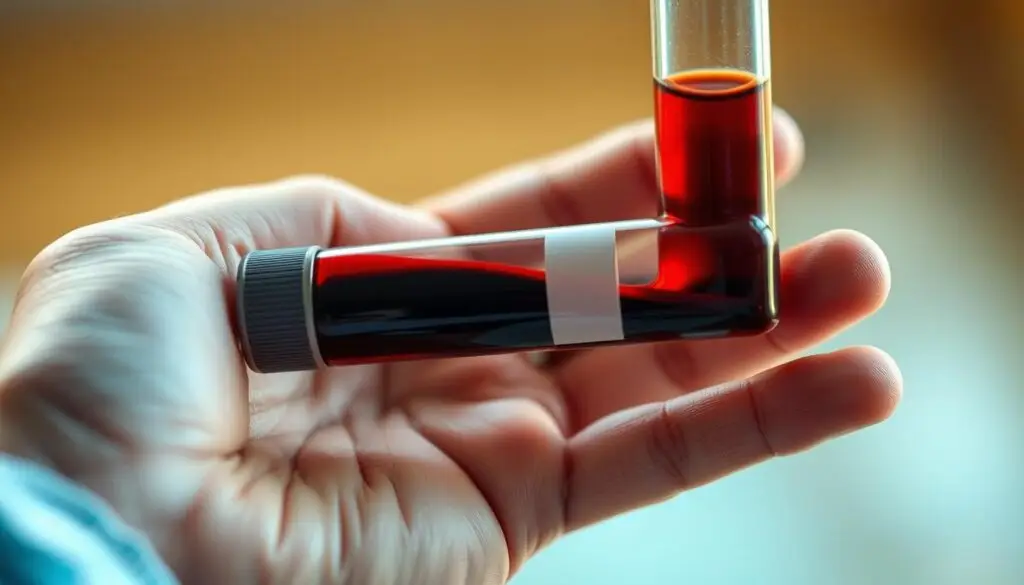Four out of 10 people in the U.S. likely have low vitamin levels, and that can quietly affect your energy, mood, and bone strength. This short guide helps you spot subtle symptoms like fatigue, bone or back pain, and frequent infections so you can act before issues worsen.
Vitamin works like a hormone to help calcium absorption and support immune function. You’ll learn what matters most, when it’s time to test your status, and practical steps—food, sunlight, and safe supplements—to lower your risk. For testing details and clinical context, see this resource from the Cleveland Clinic on testing and care: vitamin D testing and guidance.
Key Takeaways
- Low vitamin levels are common in the U.S. and can show as subtle symptoms.
- Fatigue, bone pain, and repeated illness are alerts you should not ignore.
- A 25‑hydroxy blood test confirms status; many experts cite 40–80 ng/mL as ideal.
- Sunlight, fatty fish, egg yolks, and fortified foods help restore levels.
- Check with a clinician about testing and a safe plan to rebuild reserves.
Why Vitamin D Matters for Your Body Right Now
You depend on vitamin for more than bones. It helps your body absorb calcium, which keeps bones strong and lowers fracture risk as you age.
Bones, teeth, muscles, the heart, lungs, and immune system all rely on steady levels. Newer studies link low levels with higher chances of hypertension, certain metabolic issues, and more frequent respiratory infections.
Bone health, calcium absorption, and long-term risk
Efficient calcium uptake needs sufficient vitamin. That reduces lifetime fracture risk and helps prevent osteomalacia and osteoporosis.
Immune strength, energy, and mental health benefits
Vitamin supports immune readiness and steady energy. Research ties low vitamin levels to fatigue and mood shifts, though a direct causal link with depression is still under study.
- You need vitamin for calcium absorption and durable bones.
- Levels affect immune response and recovery from seasonal illness.
- Dietary foods help, but sunlight and testing matter too.
| System | How vitamin helps | Risk when low | Practical action |
|---|---|---|---|
| Bones & Teeth | Improves calcium absorption | Fractures, weak enamel | Include fatty fish, fortified milk |
| Immune System | Boosts readiness | More infections | Safe sun exposure, test levels |
| Energy & Mood | Supports brain and muscles | Fatigue, mood swings | Track symptoms and consult clinician |
| Cardio & Metabolic | Linked in studies to regulation | Higher disease risk markers | Discuss screening if at risk |
Common Signs of Low Vitamin D You Might Be Overlooking
Many people dismiss low energy as stress, but persistent tiredness can hint at low vitamin levels. Spotting subtle symptoms early helps you act before bone or immune issues worsen.
Persistent fatigue and low energy despite rest
If sleep doesn’t refresh you, fatigue may come from poor vitamin status. Track how long tiredness lasts and whether it affects daily tasks.
Muscle aches, cramps, and weakness
Muscle soreness or sudden weakness with simple chores can point to low levels. Strength and recovery often improve once levels are restored.
Bone and lower back pain
Lingering bone pain or lower back discomfort may signal weakened bone density. When this pain joins other clues, testing is wise.
Frequent colds or infections
Getting sick more often than other people around you may mean your immune defenses are taxed. Consider checking levels if infections recur.
Mood shifts, depression, and slow healing
Mood changes or unexplained low spirits can accompany deficiency, though they aren’t a sole proof. Slow wound healing or persistent skin problems also suggest impaired repair.
Hair loss and thinning
Unexplained hair shedding can show up when other causes don’t fit. If hair loss pairs with fatigue or bone pain, it strengthens the case for testing.
“Pay attention when several small problems appear together — combined symptoms give a clearer signal than any single complaint.”
| Symptom | What to look for | When to test |
|---|---|---|
| Fatigue | Unrelieved by rest; daily drag | If lasting >2 weeks with other signs |
| Muscle issues | Aches, cramps, weakness | If strength or mobility drops |
| Bone pain | Lower back or deep aching | Persistent or worsening pain |
| Immune & hair | Frequent colds; hair thinning | Repeated infections or unexplained shedding |
Next step:If several items fit your experience, ask your clinician for a 25‑hydroxy blood test and an action plan.
How Vitamin D Deficiency Affects Your Bones and Teeth
When your body can’t absorb calcium well, bone density can fall and pain often follows. Low vitamin status reduces calcium uptake. That makes bones softer and more fragile over time.
From softening to fractures: Adults with long-term deficiency can develop osteomalacia, which causes tenderness and recurring bone pain. Over years, poor intake and absorption speed bone loss and raise your osteoporosis and fracture risk, especially at the hip, spine, and wrist.
Dental impact and oral health
Poor calcium absorption weakens enamel. That raises the chance of cavities, tooth decay, and gum inflammation (periodontitis).
- You’ll see how vitamin and calcium work together to keep bone structure strong and resilient.
- Bone pain, tenderness, and recurring aches can signal osteomalacia tied to deficiency.
- Insufficient levels increase fracture risk over time, affecting mobility and independence.
- Weak enamel and gum inflammation undermine dental health and lead to more cavities.
| Issue | Why it happens | What to watch for |
|---|---|---|
| Osteomalacia | Low mineralization from poor calcium uptake | Deep aching, tenderness, difficulty walking |
| Osteoporosis | Chronic bone loss from prolonged deficiency | Fractures after minor falls, reduced height |
| Dental problems | Weakened enamel and bone support | More cavities, loose teeth, gum swelling |
“Protecting your skeletal and dental health starts with testing and simple steps to restore levels.”
Who’s at Higher Risk for Low Vitamin Levels
Your daily routine and medical history shape how well your body makes and keeps vitamin. If you spend most hours indoors, live in a dense city, or regularly block sun with sunscreen, your production falls. Older adults and nursing home residents often get less sun and face higher risk.
Skin tone and environment matter. People with darker skin need more sun time because melanin reduces UVB-driven production. Pollution, tall buildings, and long winters also cut the sunlight that reaches you.
Medical and medication risks
Certain GI conditions limit absorption. If you have celiac disease, Crohn’s, cystic fibrosis, or had bariatric surgery, your uptake may fall.
Chronic kidney or liver disease, obesity, and drugs — antacids, antiseizure meds, statins, or steroids — can lower levels. Patients on these therapies should discuss testing with a clinician.
| Risk Factor | Why it matters | Who is affected |
|---|---|---|
| Limited sunlight | Less UVB for skin production | Indoor workers, urban residents |
| Darker skin | Higher melanin reduces synthesis | Many people with higher baseline pigmentation |
| Malabsorption | Poor intestinal uptake | Celiac, Crohn’s, bariatric patients |
| Chronic disease & meds | Impaired activation or fat sequestration | Kidney/liver disease, obese patients, those on long-term meds |
“If several factors fit your situation, ask for a 25‑hydroxy blood test and a practical plan to restore levels.”
Signs of Vitamin D Deficiency You Need to Know
Small, persistent changes in how you feel can point toward a deeper nutrient shortfall that affects bones and immune health.
Red flags in adults and children
Children: Look for bowed legs, delayed growth, or soft skull bones — classic rickets that signal low stores early.
Adults: Longstanding low levels vitamin commonly shows as osteopenia or osteoporosis on scans, which raises fracture risk.
When subtle symptoms add up
If you notice ongoing fatigue, mood changes, muscle weakness, or hair thinning, treat the pattern seriously.
Recurrent infections combined with bone or joint pain is a red flag that warrants testing and a care plan.
- Rickets in kids vs. osteopenia/osteoporosis in adults
- Fatigue, mood dips, and muscle issues that persist
- Frequent infections plus bone or joint complaints
- Share this checklist with your clinician for faster evaluation
| Age group | Typical findings | Action |
|---|---|---|
| Children | Bowed legs, delayed growth, soft bones | Ask pediatrician for testing and early treatment |
| Adults | Bone loss on imaging, fractures, deep aching | Request a 25‑hydroxy blood test and bone density check |
| All ages | Fatigue, mood shifts, muscle weakness, hair thinning, infections | Track symptoms, discuss supplements and lifestyle changes |
“Even mild, ongoing changes can precede serious bone disease — early testing prevents worse outcomes.”
Get Clarity: The Blood Test That Confirms Your Levels
A single lab result clarifies if low nutrient levels are behind persistent symptoms. The 25‑hydroxy vitamin blood test is the most accurate measure clinicians use. Ask your clinician for that exact assay so results are comparable and actionable.

What the 25‑hydroxy test shows and ideal ranges
This test reports how much is circulating in your system. Many experts cite 40–80 ng/mL as an ideal range. Levels below 20 ng/mL count as deficient and usually prompt a correction plan.
Insurance, costs, and when to talk with your doctor
Insurance may not always cover the test. Out‑of‑pocket costs commonly fall in the $100–$200 range. Check your coverage before you schedule a lab draw.
If you have ongoing fatigue, recurring infections, mood concerns or depression, discuss testing with your doctor now rather than waiting. Patients with medical risks should also ask for baseline testing and a clear follow‑up plan.
- Request the 25‑hydroxy blood test by name so labs report useful units.
- Use the 40–80 and <20 ng/mL cutoffs to interpret results with your doctor.
- Plan for re‑testing in about 8–12 weeks after starting a correction plan unless your clinician advises otherwise.
“A clear test result makes treatment precise—no guesswork, just a plan you and your doctor can follow.”
| What it measures | Typical range | When to repeat |
|---|---|---|
| Circulating 25‑hydroxy | 40–80 ng/mL ideal; <20 ng/mL deficient | 8–12 weeks after treatment begins |
| Clinical action | Low = replacement plan | More frequent if symptoms persist |
| Costs & access | $100–$200 out‑of‑pocket typical | Confirm insurance or ask doctor about alternatives |
Food First: Vitamin D-Rich Foods You Can Add Today
When sun is scarce, food becomes your most reliable source of steady vitamin intake. Start with a few pantry and fridge staples and you’ll see a practical boost in dietary intake.
Fatty fish, egg yolks, mushrooms, and fortified options
Choose fatty fish like salmon, tuna, herring, or sardines twice a week. Rotating fish keeps meals enjoyable and sustainable.
Include egg yolks and sun-exposed mushrooms for easy additions to breakfasts and salads.
Milk, yogurt, and orange juice fortified with vitamin D
Swap regular milk for fortified milk or plant milks, and pick fortified yogurt and cereals. Fortified orange juice is another quick way to add intake.
- Grocery list: fatty fish, egg yolks, mushrooms, fortified milk, yogurt, cereals, and orange juice.
- Pair vitamin foods with calcium-rich choices — this supports absorption and bone health.
- Use ready-to-eat swaps like fortified dairy or plant milks to raise intake with little effort.
“Food can maintain levels for many people, but consult a clinician about vitamin supplements if tests show low values.”
| Food | Serving idea | Benefit | When to add supplements |
|---|---|---|---|
| Salmon, sardines, tuna | Baked fillet, canned on salads | High in vitamin and omega-3s | If levels remain low after diet changes |
| Fortified milk & plant milks | In smoothies, cereal, coffee | Easy daily boost of vitamin | Helpful when sun exposure is limited |
| Egg yolks & mushrooms | Scrambled eggs, grilled mushrooms | Natural sources you can eat daily | Combine with calcium-rich sides |
| Fortified yogurt & juice | Snack or breakfast | Convenient for busy schedules | Consider supplements if tests show deficiency |
Sunlight and Safety: Smart Ways to Boost Vitamin Naturally
Short, safe sun sessions at midday can be one of the most practical ways to support natural vitamin levels. Brief exposure helps your body make vitamin while minimizing long-term harm to skin. Aim for quick, regular outdoor time rather than long, infrequent sunbathing.

Timing your exposure: brief mid-day sun without burning
For many people, about 10–15 minutes at midday works; others may need 15–20 minutes several days per week. Start small and avoid any burn. If you tan or burn easily, shorten the session and build time slowly.
How sunscreen and latitude affect production
Sunscreen reduces cutaneous production, so brief unprotected exposure before applying sunscreen may be practical for some. Remember sunscreen protects against sun damage and lowers long-term skin cancer risk.
Latitude, heavy pollution, tall buildings, and winter sunlight all limit UVB. In the Midwest and during colder months, sunlight alone may not raise levels enough. When sunlight falls short, discuss diet and supplement options with your clinician.
“Use short, consistent sun habits and adapt by season and environment to gain benefit without adding risk.”
- Practical tip: Fit short midday breaks into your daily routine for steady gains.
- Adapt by place: If you live far north or in high-pollution areas, plan alternatives.
- Balance safety: Protect skin from burns while aiming for steady, modest production.
Supplements: What to Take, How Much, and For How Long
Choosing the right supplement dose helps restore balance without adding risk. Many adults start with 1,000–2,000 IU daily. That dose often raises levels in 3–4 months for people with mild shortfalls.
Typical dosing, fat-soluble risks, and when to see a doctor
Start low and check. Because this nutrient is fat-soluble, too much can cause harm. Higher-dose regimens are sometimes needed for clear deficiency, but those usually require a prescription and medical supervision.
Pairing with calcium for stronger bones
For bone health, combine oral supplements with adequate calcium. This pairing supports mineralization and reduces fracture risk in at‑risk patients.
Monitoring progress and when to re-test
Plan a follow-up 25‑hydroxy blood test about 8–12 weeks after starting treatment. That test shows if your regimen is working and whether your doctor should adjust dose or duration.
- Choose a reputable supplement brand and read labels for dose and purity.
- Avoid megadoses without testing; labs guide safe changes.
- Coordinate with your doctor if you have medical conditions or take medications that affect absorption.
- Expect gradual symptom improvement over weeks to months as levels stabilize.
| Action | Why it matters | When to act |
|---|---|---|
| Start 1,000–2,000 IU daily | Safe for many adults; raises levels over months | When mild deficiency suspected |
| Higher-dose prescription | Rapid correction under supervision | When blood test shows significant deficiency |
| Re-test (25‑hydroxy) | Confirms progress and need for change | 8–12 weeks after starting treatment |
“Work with your doctor to pick the right supplement plan — it makes treatment safer and more effective.”
Conclusion
Conclusion
Small, steady changes in energy or hair can point toward a deeper nutrient shortfall. Low vitamin deficiency is common and often quiet, yet it can harm bone health, mood, immunity, and healing over time.
Confirm status with a 25‑hydroxy blood test (many experts cite 40–80 ng/mL as ideal;
Act early: schedule testing if several changes line up, follow a food‑first strategy, monitor levels, and adjust treatment under clinical guidance. For clinical context and evidence on muscle, falls, and population risk, see this review: serum 25OHD and health outcomes.



